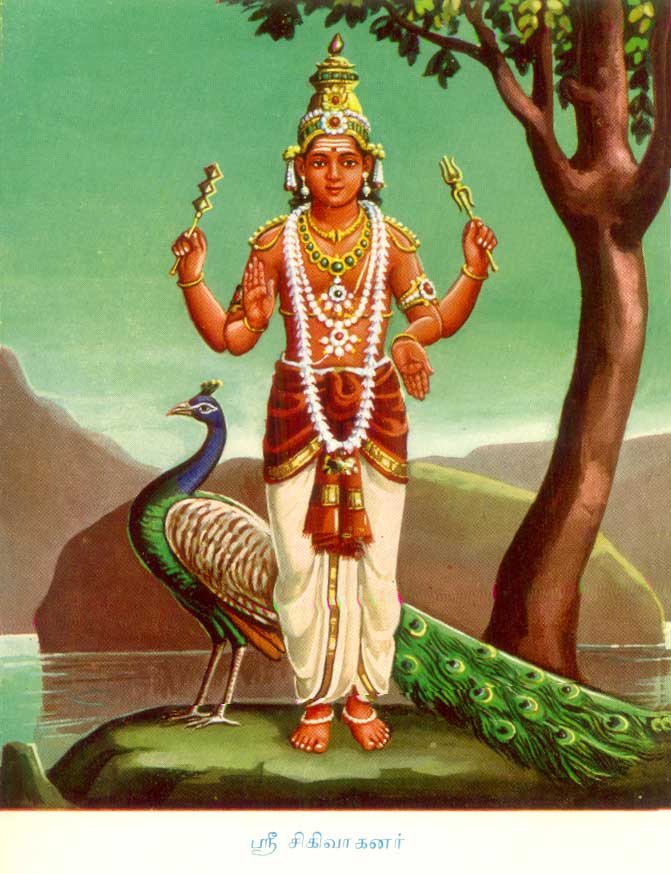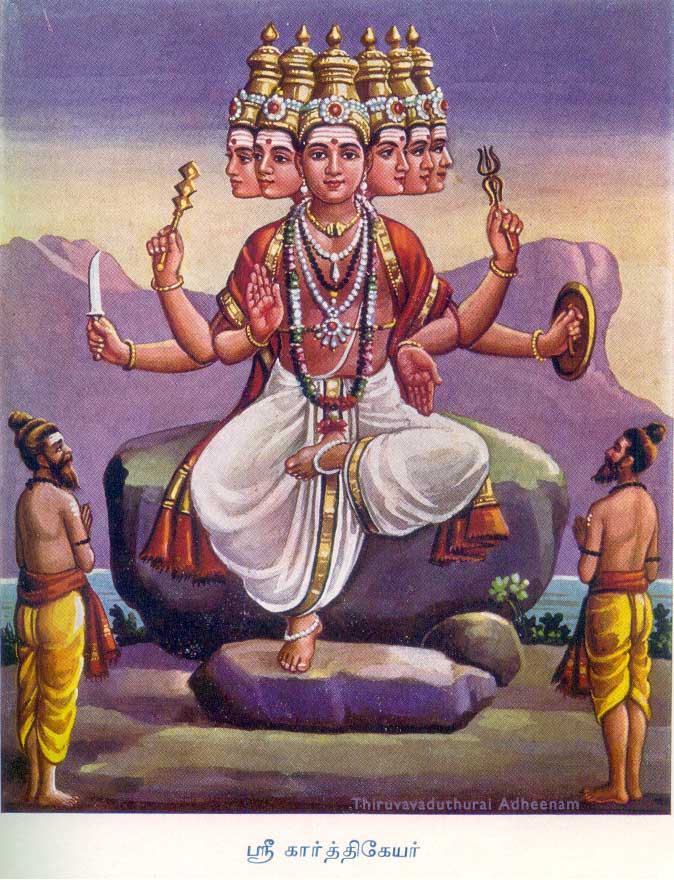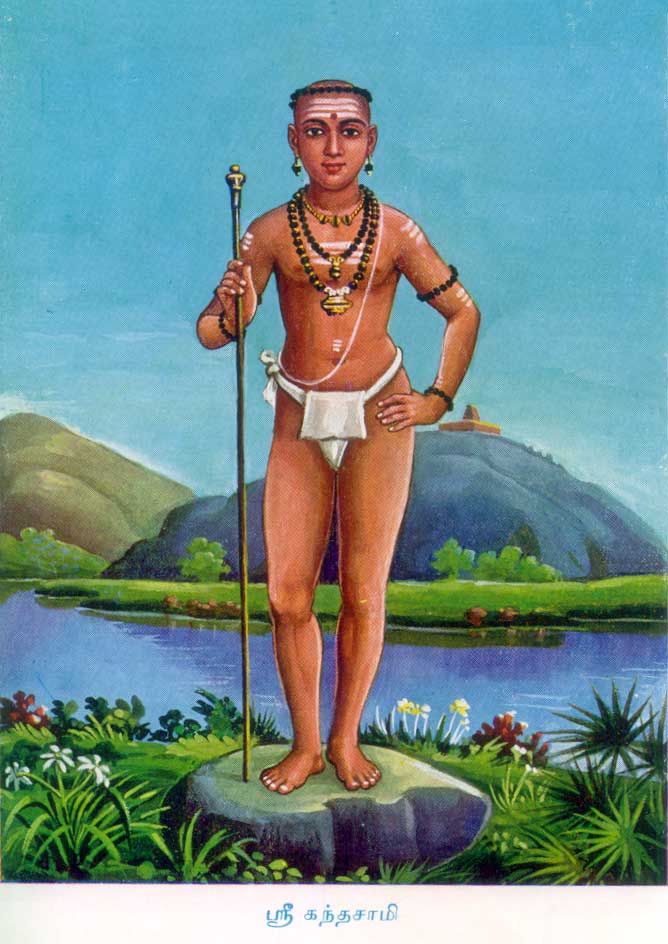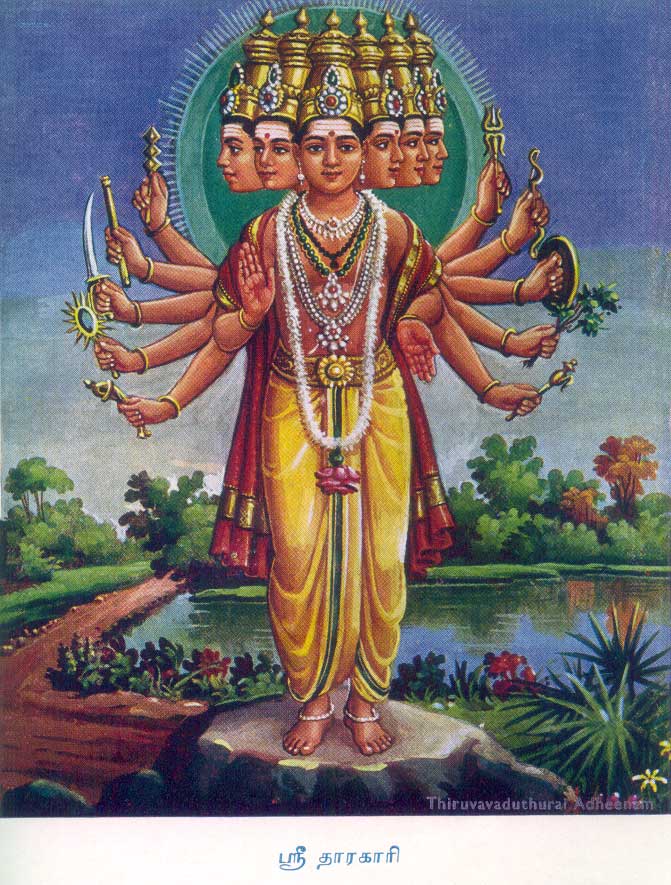The Story of Skanda
as told in the Northern and Southern Recensions
by P.R. Kannan
The story of Skanda, known popularly as Karttikeya in the north and Subrahmanya in the south, is a unique blend of beauty, power, valour and grace. The account of Skanda's birth and exploits is covered in Valmiki Ramayana, Mahabharata and Skanda Purana. Some other Puranas also make brief references to Skanda. The accounts given in the various texts differ. It is interesting to note that there are two different books, both going by the name of Skanda Purana(m), one popular in the North and the other in the South. The story of Skanda as told in these two books also differs.
Valmiki Ramayana
Balakandam, Canto 37 gives a brief account of Skanda as part of great stories of the past recounted by Viswamitra to the young Rama and Lakshmana on their way to Siddhasrama, where the royal princes were to protect yagnas from the ravages of rakshasas. Once when Devas went to Siva for protection against Asuras, Parvati cursed the devas for impatiently interfering when she and Siva were alone. The curse was that devas would not beget children. Agni, at the behest of Brahma and Indra, consumed the virya of Siva and, being unable to bear the heat, left it in the river Ganga. Ganga also could not stand the heat and left Siva's virya in a white brilliant thicket of reeds. Skanda, the divine child with six heads and twelve arms was born there instantly. The Sanskrit word, ‘skand' means slipping. As he was born of the virya that slipped from the womb of Ganga, the child came to be known as Skanda. Indra brought the six Krittika devis for suckling and bringing up the baby, who therefore came to be known as Karttikeya. The child, also called Kumara, was very powerful even at birth. Skanda was then anointed commander of the celestial army and he destroyed the asuras. There is no specific mention in this account of the name of Tarakasura or Surapadma.
Mahabharata
Markandeya instructs Yudhishthira on various divine stories of the past in Vanaparva. Chapters 224 to 232 cover the story of Skanda. Swaha Devi, daughter of Daksha Prajapati, was in love with Agni. Once she noted that Agni came under the sway of lust after seeing the wives of the great Saptarishis in a yagna. In order to lure Agni, Swaha Devi took the forms of the wives of six of the Saptarishis one by one and joined Agni. She could not adopt the form of Arundhati, wife of Vasishta, owing to her unparalleled chastity. Swaha Devi dropped Agni's virya in a golden pond in Swetaparvata. Skanda with six heads was born in the pond. Krittikas brought him up. At the behest of Indra, they later became stars in heaven by the grace of Skanda and filled the gap left by Abhijit who had gone for tapas in the forest. Viswamitra performed jatakarma of the baby and praised Skanda as Siva himself. Swaha Devi became Agni's consort.
Agni is known in Vedas as a form of Siva and Swaha Devi as Uma. Skanda is hence regarded in Mahabharata as Siva's son. Skanda's divine boyish sports showed his extraordinary power. He even fought Indra once. From Skanda's body Visakha and other warriors, collectively known as Navaviras, emanated. Later Skanda was made the commander of Indra's forces. He married Devasena, brought up by Indra as his daughter after he had rescued her from the clutches of the asura, Kesi. After worshipping Siva, Skanda led the devas' war with asuras. When the head of asuras, the terrible Mahishasura started attacking Siva himself during the war, Skanda killed him and vanquished all asuras. There is again no mention of Tarakasura or Surapadma in this account. However, in the Salyaparva, the asuras killed include Mahisha and Taraka. In the Anusasanaparva, Skanda is hailed as the destroyer of the dreaded Tarakasura.
Skanda Purana in the Northern Recension
The book published by Nag Publishers, Delhi states in Introduction that their version is considered as the authentic Skanda Purana and the Southern version is to be regarded as Agasthya Samhita. Maheswara Khandam of this Skanda Purana describes the birth and exploits of Skanda. Agni saw Siva and Parvati in Gandhamadana Parvata when they were alone. As ordered by Siva, Agni swallowed the virya of Siva. The further account of Agni's lust on seeing the wives of the Saptarishis and Swaha Devi joining Agni in the forms of six of the seven wives of the seers is same as in Mahabharata. Here the six rishis' wives are called Krittikas. One account in the Maheswara Kandam refers to Swaha Devi depositing the virya in the Ganga, while another speaks of her leaving it in a golden pond in Swetaparvata. Shanmukha was born. Viswamitra performed the birth ceremonies and praised Skanda. Agni presented the ‘shakti' weapon to Skanda. Skanda married Sena, the daughter of Mrityu. Indra made him the head of his army and prayed for the destruction of Tarakasura. Skanda sent Narada to the asura as messenger of peace. On the failure of the peace mission, fierce battle ensued. Skanda noted during the hostilities that Tarakasura was a great devotee of Siva and hence he hesitated to kill him. Vishnu informed Skanda of Tarakasura's attempt to kill Siva himself. There was Akasavani that the purpose of Skanda's birth was to kill Tarakasura and restore to devas their lost glory. Skanda then killed the asura with his ‘shakti' weapon. He reduced to ashes other powerful asuras including Krauncha.
Skanda Puranam- The Southern Recension
The story of Skanda has been told in great detail in the Siva Rahasya Kandam of Sankara Samhita of Skanda Puranam. This is extremely popular in the South. This part has been translated a few centuries ago into a great devotional Tamil poem called Kanda Puranam by Kachchiyappa Sivacharya. Many ancient temples in the South are dedicated to Skanda, commonly known also as Subrahmanya and Muruga (a Tamil term meaning a person of great beauty). Devoted crowds throng these temples, worship with fervour and remember their favourite god as the slayer of Surapadma and the husband of Devasena and Valli. A lot of ancient poetic literature in Tamil including the famous Tiruppugazh (glory of God), Tirumurugatruppadai, Pillaittamizh, Shashti Kavacham, Kandar Anubhuti, Kandar Alankaram etc. extols Skanda and is recited regularly by the devout public. All of them follow the southern version of Skanda Puranam faithfully.
The Birth of Skanda
Once upon a time devas were harshly tortured by the asuras, Surapadma and his two younger brothers, Simhamukha and Tarakasura. After severe austerities, these asuras had obtained rare and powerful boons from Siva. They would be unsurpassed rulers of 1008 Brahmandas including Swarga and Vaikuntha for a period of 108 yugas. They would meet their end only at the hands of Siva's offspring. Siva had been separated from Sati after she and Siva were insulted with disdain by Sati's father Daksha at the yagna conducted by him. Devas were in dire need of Siva's son in order to kill the Asuras and prayed long and intensely to Siva. They sent Manmatha to Siva. Manmatha aimed his flower-arrows at Siva and was reduced to ashes by the Agni from Siva's third eye. Devas continued in their prayers. In this context it is interesting to note that on one occasion all devas including Vishnu assembled in Vaikuntha. Vishnu wore vibhuti and rudraksha, chanted Śrī Rudram and led the devas in prayer. Siva appeared and assured them of his offspring. Sati was then reborn as Parvati, daughter of Himavan and performed severe tapas in order to get Siva as husband. Siva was also in tapas at the same time in order to get Parvati as his wife. In due course Siva married Parvati, the daughter of Himavan. Manmatha's wife Rati prayed to the divine couple for resurrection of Manmatha. At the intercession of Parvati, Siva brought Manmatha back to life, but with unseen form, Ananga. The devas again reiterated their prayer to Siva in Kailasa for his offspring. Once when Siva and Parvati were seated in Kailasa, the normally five-faced Siva assumed six faces and looked longingly at Parvati. From the third Agni-eye in each of the six faces of Siva, a six-faced tejas emerged, brilliant like a crore of suns and burning like Kalagni. In order to comfort the devas, who ran hither and thither, being unable to bear the heat, Siva called back the tejas and made it smaller and bearable. He ordered Agni and Vayu to carry the tejas to the thicket of white reeds in the Ganga. Agni and Vayu carried the tejas on their heads in turns with difficulty and finally left it in the Ganga. The river deposited it in a group of lotuses among a thicket of reeds. The tejas turned into a beautiful six-faced baby with twelve hands. Vishnu asked the six Krittika star-devis to suckle the newborn baby. The baby took six separate forms, who were reared by the six devis. In the meantime, discomfited by the interference of devas when Siva and Parvati were alone, Parvati cursed devas that they would not beget children. In another development the Navaratnas from her anklet turned into nine Kalikas, who gave birth instantly to Navaviras starting with Virabahu. Then Siva and Parvati visited the six babies under the care of Krittikas. Parvati brought the six babies together in an embrace. Thus was Skanda born with six brilliant faces and twelve hands.
Skanda's Childhood
The boy's lilas displayed his enormous power and valour. Once he even killed all devas including Indra in jest. At the intervention of Brihaspati they were brought back to life. Skanda graced the Devas by showing his stunning Viswarupa. Indra then explained the torture the Devas were experiencing at the hands of Surapadma and the other daityas. The demon once cut the hands and feet of devas, but found to his utter dismay that they grew again because of the Amruta they had imbibed. He even defeated Vishnu in a battle. Indra prayed to Skanda to take over the leadership of devas and guide them as Indra. Skanda asked Indra to continue in his position and offered to lead the devas' army to victory as their general. He was anointed as Devasenapati. He subdued a goat that emerged during a yagna from out of the sacrificial animal and terrified the whole world by its growing size and strength. The goat became his first vehicle, vahana.
 |
|
Valli Teyvani Samedha Murugan
|
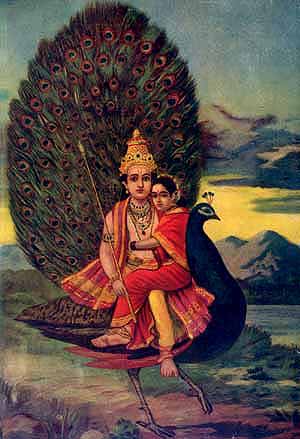
|
|
Valli Murugan
|
|
|
|
|
On another occasion, Skanda questioned Brahma on the meaning of Omkara, when the latter ignored him as a boy. Brahma replied, "I am indeed the meaning of Omkara." Skanda hit the arrogant Brahma on the head with his fist and jailed him in Skandagiri. He started performing with ease the creative function of Brahma. This unnatural occurrence led to Siva intervening personally. He went to Skandagiri and asked Skanda to release Brahma. During the discussion, Siva casually asked Skanda if he knew the meaning of Pranava. Skanda offered to explain the esoteric meaning provided Siva requested deferentially like a disciple. Siva accepted and Skanda did his part like a Guru. He thus became Swaminatha. The temple of Swaminatha at Swamimalai in Tamil Nadu is one of the six most important shrines dedicated to Skanda. An overjoyed Siva returned to Kailasa and explained to Parvati the various names of Skanda together with their import. The names mentioned in the Purana in this context include Skanda, Subrahmanya, Shanmukha, Karttikeya, Senani, Mahasena, Guha, Gangeya and Saravanabhava. Skanda is explained to mean a great warrior who can vanquish the entire world with his valour.
Battles with Asuras
Siva acceded to the repeated prayers of the devas and asked Skanda to proceed for war with the daityas. He blessed him and handed him Ekadasa Rudras as eleven weapons in his eleven hands. Parvati gave in his twelfth hand the powerful ‘Shakti' weapon (known as ‘Vel' in Tamil). The first battle Skanda waged was in the north of the country with Tarakasura. His ‘Shakti' weapon finally destroyed Tarakasura along with his lieutenant Krauncha, who had taken the form of a mountain and their large army. Offering worship at various Siva temples en route, Skanda marched southwards and reached Tiruchendur on the sea-shore near Rameswaram. He sent his brother Virabahu to Viramahendrapuram, the capital of the demon Surapadma, an island to the south of Lanka. Virabahu, the messenger of peace, who was not offered a seat in the royal court, saw a throne materialise in front of Surapadma by the grace of Skanda. On peace overtures not yielding positive results, Skanda started on the great battle. Surapadma rejected the advice of his brother Simhamukha to accept peace with Skanda, release the incarcerated Devas and return the kingdom of Swarga to them. He was sure that as he had vanquished even Vishnu in battle, the small boy was no match in valour and power to him. This is similar to Ravana not listening to his powerful brother Kumbhakarna.
The great battle with Surapadma lasted six days. During the second day, Surapadma lost all his weapons, chariot and charioteer and stood all alone in the battlefield. Skanda spared his life and permitted him to return the next day with due preparations, like Rama did with Ravana. In the first five days of the battle, all great warriors including Simhamukha and the two sons of Surapadma, Agnimukha and Bhanukopa perished.
On the sixth day, a great army of asuras from all Brahmandas descended on the battlefield. The devas became very insecure. Vishnu repeatedly assured them, "This six-faced Skanda is none other than Siva, who carries out the five great tasks of creation, protection, annihilation, concealment and grace. Where is the difficulty for him in killing these ordinary Asuras?"
The fierce battle was fought in various Brahmandas. Skanda destroyed all of Surapadma's army and brought his own entire army back to life. The lonely Surapadma was advised by his mother Maya to get the Sudhamandara hill from across the ocean. Once the hill was brought, by the very contact of its breeze, all the dead warriors including Simhamukha, Agnimukha and Bhanukopa came back to life as if from sleep. The battle fought fiercely for five days came to nought. The devas were nonplussed. Skanda then used Pasupatastra and destroyed all the warriors in one stroke. Surapadma adopted different forms through his great powers of maya – forms of Brahma, Vishnu, Rudra, Asura, terrible animals like bull and lion, birds like chakravaka, wind, fire, darkness, ocean. Skanda extinguished all those forms. He then graced devas by showing his own Viswarupa, which included devas, Vedas, asuras, humans etc. Brahmandas were seen hanging at the ends of hairs on his body. Surapadma, who also had this unique darshan, temporarily developed intense devotion towards Skanda, the son of Siva at that time.
Once Skanda changed from Viswarupa to his normal boyish appearance, Surapadma became his former demonist self and restarted his fight ferociously, assuming different forms again. Finally he took the form of a huge mango tree. Skanda's ‘Shakti' cleaved the tree into two. The asura came back to his normal form and rushed at Skanda with a sword. Skanda's ‘Shakti' again split the asura into two. The two parts turned into a fierce peacock and cock, both pouncing at Skanda. At that very instant, in an unexpected development, by a mere glance of supreme grace, Skanda pacified the two animals and blessed them with vignana (Supreme Self-experience) and took them as his vehicle and flag. Such was Skanda's mercy even to his sworn enemies. Surapadma in his previous life had been Sura and Padma, two bhootas, who had prayed to Subrahmanya to become his flag and vahana, the cock and peacock. Their prayer was now answered.
Skanda's Marriage
Amritavalli and Saundaravalli were two daughters of Vishnu born from his eyes. They developed undying love for Skanda and performed severe austerities to obtain him as husband. At Skanda's instructions, Amritavalli incarnated as Devasena, a young girl under the guardianship of Indra in Swarga. Saundaravalli took the form of Valli, a lass under the protection of Nambiraja, a hunter near Kanchipuram. ‘Valli' is a Tamil term for the Sanskrit ‘Lavali', a kind of creeper. As she was found among the creepers as a baby, the hunter called her ‘Valli'. After the war with Surapadma was over, the devas were overjoyed. Skanda acceded to Indra's prayer to accept Devasena as his consort. The divine wedding was celebrated with great enthusiasm at Tirupparankundram near Madurai in the presence of Parvati and Siva. Indra's recoronation in Amaravati in Swarga followed. Devas regained their power and positions. Skanda took his home in Skandagiri. He then proceeded to Tiruttani near Chennai, where Valli was looking after barley fields. After a series of sportive love-pranks, in which his brother Vighneswara also lent a helping hand, he married her.
Jayanta, son of Indra later curiously asked Brihaspati as to why the devas had to suffer so much for so long. The Devaguru replied, "Inscrutable are the ways of karma. He explained that devas had committed a grievous sin by participating in the yagna conducted by Daksha in which offering of Havirbhaga to Siva was ignored. On the spot they suffered torture at the hands of Virabhadra and Bhadrakali, who destroyed the yagna. The balance of karma bore fruit in the form of untold suffering over a long period.
The Skanda Puranam contains a number of soul-stirring prayers including Siva Sahasranamam. Śrī Rudram is explained in an entire chapter in beautiful verses. The greatness of vibhuti and rudraksham is brought out through many stories. A number of passages teach bhakti and other values of life. When Virabahu destroys the invincible Bhanukopa, Skanda offers him boon. Virabahu says: "Please do not give me the position of great revas like Brahma and Vishnu. Please grant me unflinching and eternal bhakti at your lotus feet." At Tirupparankundram, Skanda taught Sivagnana to six sons of sage Parasara, the elder brothers of Bhagavan Vyasa. Skanda's consort Devasena represents Ichcha Shakti, whereas Valli stands for Kriya Shakti. The ‘Shakti' weapon in the hand of Skanda is Gnana Shakti. In the South, where Skanda is worshipped with special devotion, bhaktas observe vrata, upavasa, etc. regularly on days of Sukla Paksha Shahti, Krittika star and Fridays. In addition, special worship is offered on days of Vaisakha Visakham (celebrated as the birthday of Skanda), Ashadha Krittika, Aswina Shashti (which is known as Skanda Shashti, the day on which Surapadma was killed), Pausha Krittika and Phalguni Uthiraphalguni (when the marriages with Devasena and Valli are celebrated). Many devotees carry on their shoulder the ceremonial ‘kavadi' containing milk, perfume water etc. to the temple. They recite devotional songs like Tiruppugazh and Shashti Kavacham and offer congregational prayers. Many homams and poojas offering prayers to Skanda, Devasena and Valli amid chanting of the Vedic Śrī Rudram, Chamakam and Durgasuktham are conducted. Religious discourses on Skanda Puranam are held.
As per our tradition the differences in detail in regard to Skanda's story among the various ancient texts do not detract from their veracity or purpose. We regard all versions as true, enjoy the various lilas of Bhagavan and derive spiritual benefit from them. This is similar to the accounts of fate met by Parikshit, Vritra's story etc. as described in Srimad Bhagavatam and Devi Bhagavatam. God's ways are inscrutable for the ordinary mortal. The events depicted in various puranas might have happened in different Kalpas. The rishis of yore have visualised them with their mental eye and recorded them for the benefit of posterity. May Skanda's blessings be always with us.
VALLI DEVASENA SKANDA SMARANAM -- JAYA JAYA SUBRAHMANYAM!
|



